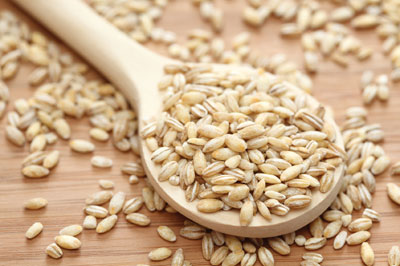
The Final Proof: May 2012
April 19, 2012
By Jane Dummer RD
This small grain packs big nutritional value for its consumers, not too mention taste and satiety
This small grain packs big nutritional value for its consumers, not too mention taste and satiety
 |
|
| Barley is rich in beta glucan, a viscous soluble fibre proven effective in lowering blood cholesterol.
|
Barley is a tiny grain with a big nutritional punch, and bakers and food scientists are becoming more and more aware of the nutritional and functional impacts of barley in baked products. “We have seen an increase in momentum for the use of barley flours into consumer favourites, such as pan breads, muffins and cakes, which can significantly enhance the nutritional qualities of the end product,” says Sunny Mathew, corporate quality assurance manager for Parrheim Foods, a miller of barley flour located in Saskatchewan.
Barley is rich in beta glucan, a type of viscous soluble fibre that plays a role in human health. Studies demonstrate that this soluble fibre is effective in lowering blood cholesterol and may reduce the risk of heart disease. Barley is considered a low glycemic index (GI) food. Diets that include low GI foods assist in the management of blood sugar for people with diabetes. Research shows that the beta glucan found in barley promotes healthy blood sugar by slowing glucose absorption in people who are well. The soluble fibre in barley can help promote a feeling of satiety, which may assist people in weight management. Also, barley contains several vitamins and minerals including niacin (vitamin B3), thiamine (vitamin B1), selenium, iron, magnesium, zinc, phosphorus and copper.
With that in mind, it is not surprising that in 2005 the United States Food and Drug Administration approved a health claim stating barley reduces the risk of coronary disease. As well, the soluble fibre in barley and barley products, such as barley flakes, grits, flour and meal, is a key ingredient in reducing cholesterol and assisting in weight control. We are not currently able to make a similar health claim in Canada; however, it is hoped that a claim may be approved within the next year.
Arun Lekhi, quality assurance manager for Parrheim Foods in Lethbridge, Alta., explains, “With the milling process of the hull-less barley, there is no change to the functionality of the beta glucans. Barley flour is very versatile and over the past five years we have seen an increase in its uses for the commercial baking industry. For home baking, people can replace regular wheat flour with 15 per cent barley flour with minimal noticeable changes, while benefiting from the nutritional improvements. We have a variety of barley flours for the food industry including whole grain, beta glucan and malt. The malt barley flour is popular with artisan bakers as it aids in the fermentation process.”
Linda Whitworth, market development manager at the Alberta Barely Commission, explains, “Barley has been consumed as a grain since 800 BC; however, over 80 per cent of the barley grown in Canada is for animal feed. The commission has a variety of consumer-friendly recipes (check out the recipe for applesauce raisin cookies on page 8) and will work towards an extensive education program focusing on how people can include more barley in their diets over the next five years. Barley has a rich, nutty taste that is very complementary when incorporated in recipes for baked goods.” The Alberta Barley Commission is developing a workshop for artisan bakers this year. If you’re interested, contact the commission directly for further details.
As I research my column for Bakers Journal, I enjoy learning new things. The lesson this time? Diastatic malt from barley flour contains a collection of enzymes that help the yeast to grow by breaking down starch into sugar. Since the yeast has more available sugar to feed on, it can grow faster and better, which enhances the rise and volume of the loaf. Linda Whitworth introduced this concept to me when she was discussing the artisan bakers workshop.
Barley is a powerhouse of nutrition and with its versatility it is being used in a wide variety of baking applications. It is exciting that the baking industry and consumers are embracing this Canadian grain, and I’m sure we will see more to come.
Jane Dummer, RD, is a leading dietitian for the Canadian food and nutrition industry. Jane offers services specializing in agri-food, functional foods and food safety. For more information, visit www.janedummer.com .
Print this page
Leave a Reply